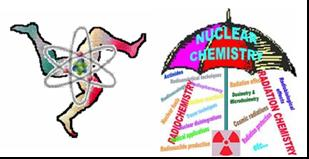Speaker
Ms
Izabela Cydzik
(Joint Research Centre European Commission, IHCP)
Description
Nanoparticles (NPs) have been used in a variety of applications for many decades, without specific attention being given to safety issues that may be due to their small dimensions. Examples of products in which NPs are used are suncreams, printer toners, car tyres, and pigments. In recent years, the rapid growth of the field of nanotechnology has seen surge in the number of different types of NPs used in industrial processes and consumer products. This has given rise to concern as to whether materials in the form of nanoparticles can be considered equivalent to the same material in coarser powder form for safety assessments. Safety studies require knowledge of the behaviour of NPs, and this in turn requires a method of reliably detecting them and assessing their concentrations. Radiolabelling represents one of the most sensitive and quantitative techniques for this, but also poses several practical difficulties.
For safety studies, ideally the material produced and supplied by industry should be used. However radiotracers cannot easily be incorporated into the industrial process, so post-synthesis radiolabelling needs to be used. While surface attachment of radiolabels, via chelating molecules, is an option, this also poses questions regarding changed NP properties due to the surface modifications, and also the stability of the NP-radiolabel construct in different environments. Alternatively, neutron or ion-beam irradiation can be used, under carefully controlled conditions, to directly activate most industrial NPs, but some types cannot be activated to useful levels due to the absence of a suitable reaction product under irradiation. More specifically silica and alumina cannot be directly activated to useful activity levels, and carbon-based NPs (nanotubes, etc.) need a proton beam of more than about 32 MeV to achieve reasonable activity levels. We describe here a recoil method for 7Be labelling of such NPs, based on the 7Li(p,n) 7Be reaction. The NPs of interest are mixed with a powder of an appropriate Li-containing compound, and the mixture is irradiated with a proton beam of approximately 5 to 3 MeV on target. The 7Be radionuclides recoil as a result of momentum transfer and energy release during the nuclear reaction process, and a fraction of these are implanted into the NPs to be labelled. The Li containing compound may then be “washed” off the NPs, leaving stably 7Be radiolabelled material. Theoretical considerations on various aspects, including recoil range and thermal effects, are presented, and initial experimental results are given for recoil labelling of SiO2, Al2O3, carbon nanotubes, carbon “buckyballs” and nanodiamonds.
Author
Ms
Izabela Cydzik
(Joint Research Centre European Commission, IHCP)
Co-authors
Mr
Antonio Bulgheroni
(Joint Research Centre, European Commission IHCP)
Ms
Federica Simonelli
(Joint Research Centre, European Commission IHCP)
Mr
Giulio Cotogno
(Joint Research Centre, European Commission IHCP)
Mr
Jan Kozempel
(Joint Research Centre, European Commission IHCP)
Mr
Kamel Abbas
(Joint Research Centre, European Commission IHCP)
Mr
Neil Gibson
(Joint Research Centre, European Commission IHCP)
Mr
Uwe Holzwarth
(Joint Research Centre, European Commission IHCP)
